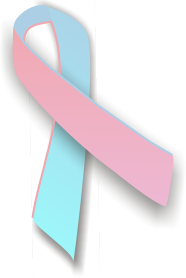Male breast cancer
| Male breast cancer | |
|---|---|
 |
|
| The pink and blue ribbon is used for awareness of male breast cancer. | |
| Classification and external resources | |
| Specialty | Oncology |
| ICD-10 | C50 |
| ICD-9-CM | 175,175.0,175.9, |
| OMIM | 114480 |
| MedlinePlus | 000913 |
| eMedicine | Template:EMedicine 2 |
| MeSH | D001943 |
Male breast cancer (male breast neoplasm) is a rare cancer in males that originates from the breast. Many males with breast cancer have inherited a BRCA mutation, but there are other causes, including alcohol abuse and exposure to certain hormones and ionizing radiation.
As it presents a similar pathology as female breast cancer, assessment and treatment relies on experiences and guidelines that have been developed in female patients. The optimal treatment is currently not known.
About one percent of breast cancer develops in males. It is estimated that about 2,140 new cases are diagnosed annually in the United States (US) and about 300 in the United Kingdom (UK). The number of annual deaths in the US is about 440 (for 2016 "but fairly stable over the last 30 years"). In a study from India, eight out of 1,200 (0.7%) male cancer diagnoses in a pathology review represented breast cancer. Incidence of male breast cancer has been increasing which raises the probability of other family members developing the disease. The relative risk of breast cancer for a female with an affected brother is approximately 30% higher than for a female with an affected sister. The tumor can occur over a wide age range, but typically appears in males in their sixties and seventies.
Known risk factors include radiation exposure, exposure to female hormones (estrogen), and genetic factors. High estrogen exposure may occur by medications, obesity, or liver disease, and genetic links include a high prevalence of female breast cancer in close relatives. Chronic alcoholism has been linked to male breast cancer. The highest risk for male breast cancer is carried by males with Klinefelter syndrome. Male BRCA mutation carriers are thought to be at higher risk for breast cancer as well, with roughly 10% of male breast cancer cases carrying BRCA2 mutations, and BRCA1 mutation being in the minority.
As in females, infiltrating ductal carcinoma is the most common type. While intraductal cancer, inflammatory carcinoma, and Paget's disease of the nipple have been described, lobular carcinoma in situ has not been seen in males. Breast cancer in males spreads via lymphatics and blood stream like female breast cancer. Accordingly, the TNM staging system for breast cancer is the same for males and females.
...
Wikipedia
